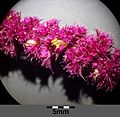Garden foxtail
| Garden foxtail | ||||||||||||
|---|---|---|---|---|---|---|---|---|---|---|---|---|

Garden foxtail ( Amaranthus caudatus ) |
||||||||||||
| Systematics | ||||||||||||
|
||||||||||||
| Scientific name | ||||||||||||
| Amaranthus caudatus | ||||||||||||
| L. |
The garden foxtail ( Amaranthus caudatus ) also known as Tausendschön, known in the Andean region under the Quechua word Kiwicha , is a plant species from the genus Amaranthus ( Amaranthus ) native to South America .
features
The garden foxtail is an annual, monoecious , herbaceous plant that reaches heights of 30 to 100 (rarely 150-200) centimeters. It forms tap roots, which are often reddish or pink in color in the upper part. The sparsely branched or unbranched, stem is light green to reddish purple, glabrous below and sparsely hairy above and often curved at the tip. The green, bald or sparsely hairy, sometimes reddish, purple, simple leaves are pinnate, ovate, their leaf margin is smooth or slightly wavy, with a furrowed stalk, these are spirally alternate and up to 20 cm long and up to 8 cm wide and with a pointed to rounded tip and without stipules .
The inflorescence is up to 1.5 m long and consists of numerous flower clusters, is terminal and, fully developed, hangs from the base. It is mostly dark purple in color, but can also have other colors; green, yellow, pink, orange, red or brown. For example, the inflorescences of the Viridis variety are initially green and later turn creamy in color.
The sessile flowers are 2 to 3 millimeters in size, are five-fold, with pointed, spatulate, overlapping tepals . The like the flowers colored, mostly three, 3–4 millimeter long bracts are lanceolate with a long tip. The male flowers have five stamens, the female flowers have three stigmas and an upper ovary, which is larger than the inflorescence when fully mature. They are self-fertilized as well as cross- pollinated .
A single-seeded, spherical, ovoid capsule (a pyxidium or utricle) that pops open with a ring crack develops; it is approx. 1.5 to 2.5 millimeters in size, these are slightly larger than the flower envelope. The lens-like (lenticular), ellipsoidal pseudo cereal seeds are about 1 to 1.5 millimeters long, smooth, shiny, ivory, red or dark brown. The dicotyledonous embryo is applied krummläufig (kampylotrop) and surrounds the starch-rich Perisperm median, it is epigeal sprouting. The thousand grain mass is only 0.5 to 3 grams.
It grows up to an altitude of 3200 meters, but is not frost-resistant and can thrive on sandy and loamy, well-drained, slightly acidic to alkaline soils, the temperature range is 5–35 ° C, it prefers a large amount of rainfall. It is a C4 plant and qualitative short day plant (KTP), the flowering period extends from July to September. The yield is around 500–4000 kg / ha.
The number of chromosomes is 2n = 34 or 2n = 32.
Occurrence
The garden foxtail is only known from culture. It probably developed from Amaranthus quitensis , which is common on river banks in extratropical America. There are overgrown stocks in the temperate and warm zones.
use
The Kiwicha has been cultivated in the Andes and Central America for several thousand years . In pre-colonial times, their grains served as an important source of protein. They were also used as offerings in religious ceremonies, which is why the Spanish colonial rulers suppressed the cultivation. Nevertheless, the culture has remained regional to this day. In recent years the cultivation has increased again. The plant is also becoming increasingly important in organic farming .
As grain crops is Amaranthus caudatus in Peru , Bolivia , northern Argentina and in the Himalayas from Kashmir to Bhutan grown. In Europe, the garden foxtail is used as an ornamental plant in cottage gardens , summer flower beds, summer borders, as a cut flower and as a dried flower . The species has been in culture in Europe since at least 1568.
Web links
- Thomas Meyer: Data sheet with identification key and photos at Flora-de: Flora von Deutschland (old name of the website: Flowers in Swabia )
- Garden Foxtail (Amaranthus caudatus) on plant-lexikon.com, accessed on May 28, 2017.
- Amaranthus caudatus from Useful Tropical Plants, accessed May 29, 2017.
- Amaranthus caudatus from vPlants, accessed June 2, 2017.
Individual evidence
- ↑ Maria Marten: Letter, Spirit and Nature. Dissertation, Univ. Hamburg, 2007/2008, Vestigia Bibliae, Vol. 29/30, Lang, 2010, ISBN 978-3-0343-0336-1 , p. 105.
- ↑ a b Kiwicha (Amaranthus caudatus) El Pequeño Grano que Nutre y Cura a la Vez. On: peruecologico.com.pe.
- ↑ Lost Crops of the Incas: Little-Known Plants of the Andes with Promise for Worldwide Cultivation. Office of International Affairs (OIA), 1989, ISBN 978-0-309-04264-2 : Kiwicha, online .
- ↑ a b c d e Eckehart J. Jäger, Friedrich Ebel, Peter Hanelt, Gerd K. Müller (eds.): Rothmaler - Exkursionsflora von Deutschland. Volume 5: Herbaceous ornamental and useful plants . Spectrum Academic Publishing House, Berlin / Heidelberg 2008, ISBN 978-3-8274-0918-8 , p. 197 .
- ↑ Colin W. Wrigley et al. a .: Encyclopedia of Food Grains. Vol. 1, Second Edition, Academic Press, 2016, ISBN 978-0-12-803537-5 , pp. 288 f.
- ^ A b c M. Brinck, G. Belay: Plant Resources of Tropical Africa. 1: Cereals and pulses, Prota, Backhuys, 2006, ISBN 90-5782-170-2 , p. 17 ff.
- ↑ J. Esteban Hernández Bermejo, J. León: Neglected Crops: 1492 from a different perspective. FAO plant production and protection series, Volume 26, FAO, 1994, ISBN 92-5-103217-3 , p. 145.
- ^ Erich Oberdorfer : Plant-sociological excursion flora for Germany and neighboring areas. 8th edition. Verlag Eugen Ulmer, Stuttgart 2001, ISBN 3-8001-3131-5 . P. 355.
- ↑ Working group for nutritional research: Amaranth - the immortal grain of the Incas. ( Memento from November 25, 2011 in the Internet Archive ).



